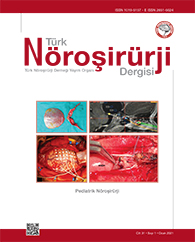Türk Nöroşirürji Dergisi
2021 , Vol 31 , Num 1
Intrauterine Treatment of Spina Bifida and Hydrocephalus; Experimental Studies and Clinical Applications from the Past to the Present
1Cincinnati Children?s Hospital and Medical Center, Center for Fetal and Placental Research, Division of Pediatric General and Thoracic Surgery, Cincinnati, ABD
In this review, clinical experiences with animal models in the treatment of intrauterine spina bifida and hydrocephalus from the past
to the present, future developments, and our innovative latest research and clinical experiences as the Cincinnati Fetal Center within
the Cincinnati Children"s Hospital are summarized. Intrauterine spina bifida treatment can be applied worldwide either with the open
or fetoscopic method. Fetal centers apply the methods they adopt according to their own experiences and research results. These
methods were discussed in the light of the literature and the experience of our center. Despite the early experiences and negative
results in the past in fetal hydrocephalus, advances in prenatal diagnosis, patient selection, and fetal surgical techniques have led to
a renewed interest in fetal intervention. Animal models and clinical evidence suggest that intrauterine treatment and especially fetal
endoscopic third ventriculostomy will be reasonable to prevent irreversible brain damage, especially in early-onset isolated hydrocephalus. As the research laboratory within the Cincinnati Fetal Center, we continue to work on the use of stem cells
in the treatment of intrauterine spina bifida and hydrocephalus, and in collaboration with bioengineers to design newly adapted
instruments and new biomaterials that are ideal, in order to further develop fetal endoscopic techniques.
Anahtar Kelimeler :
Intrauterine treatment, Spina bifida, Hydrocephalus, Fetal surgery, Fetal endoscopic third ventriculostomy, Sheep, Fetus

